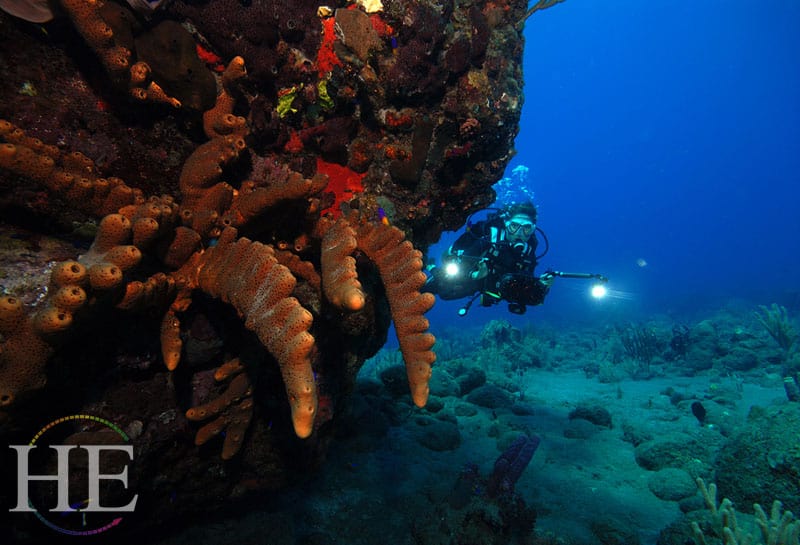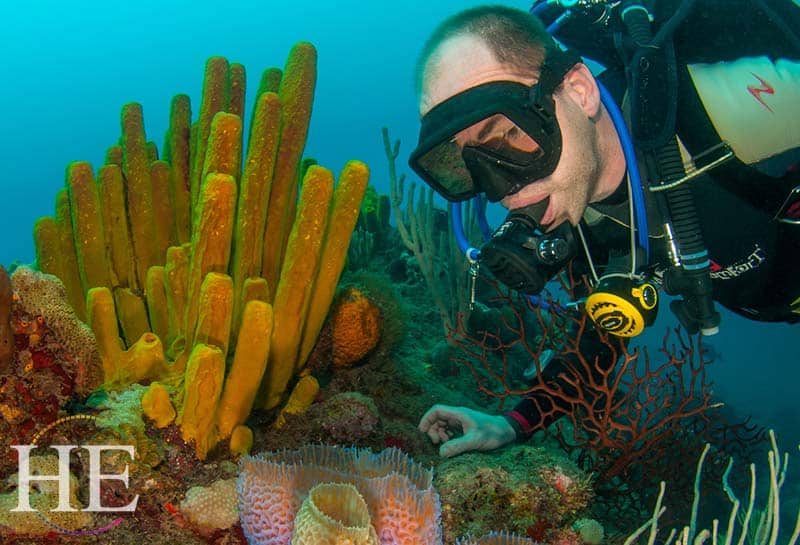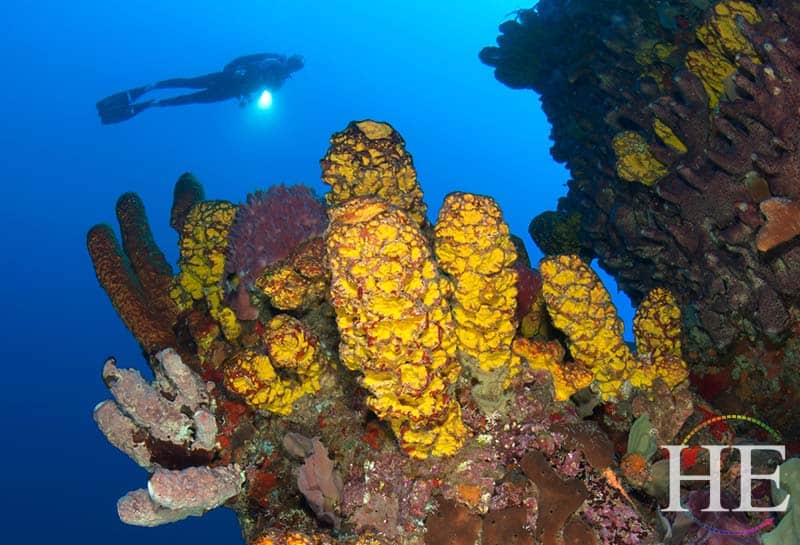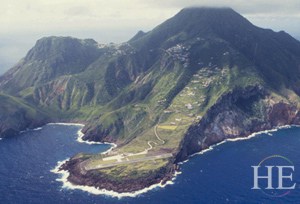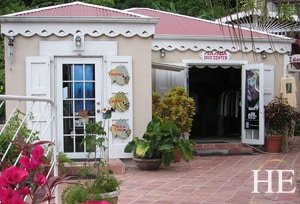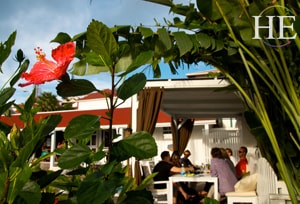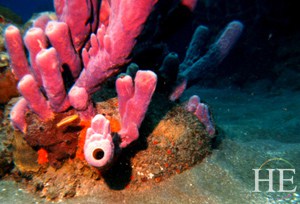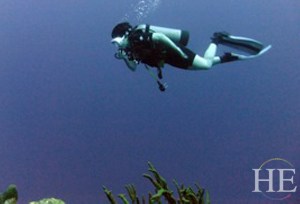Octopus’s Garden: Gay Scuba Diving in Saba
A Gay Travel Scuba Diving Adventure in Caribbean Saba
Prices listed are per person:
Shared Room: $TBA
Private Room: $TBA
Join this gay scuba diving tour and plunge into the tropical Caribbean waters of a gay-friendly island paradise! Discover a colorful world beneath the waves. Far from the usual vacation spots, the Dutch island of Saba is known to scuba divers worldwide for its spectacular underwater landscapes. Read more about Saba on our Gay Travel Blog.
Highlights
Dive in a pristine underwater marine park, amidst hot springs, lava tunnels, and pinnacles that soar up from the black depths below.
Swim with a school of small angelfish, then a giant grouper, rays, and sea turtles.
If you are a novice diver, take diving lessons in a beautiful tropical pool.
Take a day off from diving for a hike to the banana trees and wild orchids that populate the rain forest atop 2864-ft. Mt. Scenery.
Discover the island’s creative cuisines, mixing European, Chinese, Indonesian, and West Indian Creole styles.
For new divers, we strongly recommend taking the new E-Learning program developed by PADI. This will get you out of the pool and into the sea faster, and you’ll be diving more of the week with our more experienced divers.
Overview
Scuba diving on a gay-friendly Caribbean island
Dive into the tropical waters of a gay-friendly island paradise, and discover the colorful world beneath the waves. Far from the usual vacation spots, the Dutch island of Saba, in the Caribbean, is known to scuba divers worldwide for its spectacular underwater landscapes.
Join us at a comfortable guesthouse on this lush island. Beginners will learn safe scuba diving techniques in a pool and in the clear Caribbean waters. PADI and NAUI certified scuba divers get 11 boat dives, over five days, with Nitrox available for a small extra charge. We’ll have time, too, for wandering the gingerbread villages of Windwardside and The Bottom and to explore the island’s extinct volcano and rainforest.
Itinerary
Map:
Day 1: Meeting Day
Our adventure begins when you spot the airstrip on which your pilot intends to land. The residents of this volcanic island found a plot of level land just large enough to hold the world’s smallest international airport. Fortunately, the pilot has made this landing many times before and rolls to a halt with half the runway still to spare. Five minutes after touching down, you’ve already cleared Saban immigration, collected your luggage, and are on a winding road toward our hotel. Small airports have their advantages!
Our home for seven nights is a friendly hotel overlooking the turquoise Caribbean waters, where you’ll soon be diving. At our brief orientation, you meet our group and get information about the activities for the week.
If you arrive early enough, explore the small town of Windwardside this afternoon. After watching a glassblower craft colorful fish, you’ll have no trouble coming up with gift ideas to take back home. Then we’ve planned a welcome reception, followed by a Saban barbeque dinner.
If your previous Caribbean visits have always been too large resort islands, you’re in for a wonderful surprise when you reach Saba. This tiny Dutch island (population 1,400) is the complete antithesis of a typical resort. Everyone seems to know everyone else. Soon you’ll feel like you’re at home as you walk through Windwardside.
Day 2: Song of the Whale
Awake to the crowing of a distant rooster, then choose between an omelet, fresh fruit, and cheese, or other hearty breakfasts. The following is a description of a typical week, but the final itinerary for each day is decided by the Divemaster and Captain based on weather, water, and other conditions.
The first morning, certified divers will head out to a dive site known as Coregut, just a 20-minute boat ride away. This is a spectacular wall dive, featuring Giant Brain Coral, and a large outcropping of Elkhorn Coral. Colorful Parrotfish, the size of a small child, often hang out here, as do brilliant blue-and-yellow Queen Angelfish.
Pause for a moment, as you hover 50 feet below the surface. The slow, haunting music of whale songs floats in from the distance. Occasionally whales and dolphins are spotted here; more often, we are aware of their presence only from their songs.
Our second dive is at Big Rock Market. Bright purple tube sponges sway gracefully from a bed of coral. A Trunkfish, with its distinctive triangular profile, hovers nearby. Several Fairy Basslets, brilliant purple and yellow, dart about. Two giant boulders display coral and sponges of nearly every color: yellow, orange, blue, red, and purple. A lobster pokes its spiny head from beneath one boulder.
We’ll be back in Windwardside about 2:00 pm, allowing time to admire the gingerbread homes of this charming island. Don’t be surprised if you meet gay and lesbian visitors from Europe or North America on Saba for holidays.
Those not yet certified will do classroom work this morning unless all have completed the PADI E-Learning course, in which case you start right out in the water. You learn basic skills in the hotel pool, and you’ll have the thrill of breathing underwater for the first time in your life. Practice the all-important scuba diving skill known as buoyancy control — adjusting the air in your inflatable vest so that you can hover motionless at any depth you choose, ascending or descending with only a slight kick. This will be a full day, ending about 4:00 or 5:00 pm — in time for you to join others for complimentary drinks on the terrace.
And now, we’ll find out what the chef has planned for dinner!
Day 3: An Octopus’s Garden
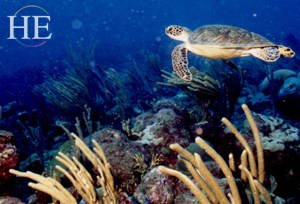
Today, certified divers start at Third Encounter Plateau. This plateau marks the top of an undersea mountain, dropping off 1,000 feet on the sides. Yet, like other dive sites here, it’s only a fifteen-minute boat ride from the dock.
Eighty feet below the surface, a four-foot Nurse Shark rests on the sandy bottom, below a coral overhang. In the distance, a black-tip shark glides silently through the still waters.
These two species of shark are common around Saba. Forget what you’ve seen in movies and on television about sharks: You can feel quite safe, particularly around these species, as long as you don’t provoke them. And provoking them is something that nobody seems inclined to do.
We take our lunch break at Diamond Rock, a formation that greatly resembles a Spanish galleon, sails unfurled, perched on the sea. Snorkeling is excellent here. An octopus lopes over coral-encrusted boulders on the way to a garden of undulating sponges, then hovers silently, its eyes toward us, curiously watching us as we watch it.
Our afternoon dive is on Tent Reef, deservedly Saba’s most popular scuba and snorkel destination. At depths of just 15 to 50 feet, Tent Reef offers an abundant variety of coral, fish, and other sea life.
A Southern Sting Ray lies on the bottom, covered with sand except for two protruding eyes. With a flap of its wings, the ray glides away as we approach. A Spotted Moray Eel pushes its head from a cave, its mouth rhythmically opening and shutting. This isn’t hunger or laughter, but merely the way eels breathe.
Our scuba diving students will finish their second day of class and pool practice today. You’ve learned to use your dive charts to plan a safe dive. In the water, you’ve practiced handling minor problems, such as how to clear a flooded facemask, and how to share air with a buddy in a real emergency.
When diving and lessons are done, a van tour gives us time to appreciate this unique island. Legend has it that Captain Morgan, the buccaneer, deposited hostages here, confident they couldn’t escape. (Or, perhaps, that they wouldn’t wish to!) Dutch, Swedish, and Scottish settlers joined them. Today, Saba is a Dutch territory with a high standard of living, and a crime rate so low as to be virtually unmeasurable.
A winding road — or is it a roller-coaster? — connects the villages of Hell’s Gate, Windwardside, and The Bottom. All homes, old and new, reflect a common tradition: red roofs, white sides, and green shutters. Sabans are particularly proud of their road, which they built over two decades in the mid-1900s after Swiss engineers assured them it would be impossible.
Following the tour, relax at the pool. Then plan dinner: if your sense of adventure extends to the dinner table, try stewed octopus. For others, a broiled lobster, T-bone steak, or vegetarian entree may be just the thing. Afterward, we’ll enjoy the twinkling of a star-lit sky.
Day 4: Lava Tubes and a Seahorse
An alert pelican watches as we board the dive boat, ready to help out with any unwanted fish. Not far from yesterday’s first dive lies Outer Limits. Here we follow a narrow underwater ridge. As you swim amidst a school of Creole Wrasses, look over the edge of the ridge to see the wall plunge straight down, dissolving into the black depths. An elongated trumpet fish floats by, looking like a refugee from a Dr. Seuss story.
Certified divers typically get three dives today; those becoming certified will join in for the second and third.
Much of the colorful coral around Saba has grown on giant boulders that tumbled from the cliffs, as waves pounded the shore over many millennia. This is evident at a dive site known as Porites Point, where enormous rocks are fused together by centuries of coral growth. A spiny lobster peers out from under one boulder shelf. Don’t be alarmed if you spot one or two barracuda hovering in the depths — like other sea life, if you leave them alone, they’ll return the favor.
An abundance of new sights and experiences await us at the site known as Hot Springs. The same volcanic activity that created Saba also vents hot water through a few diffuse cracks in the ocean floor. The hot water disperses too quickly to be felt, but when you bury your hand in the sand, the warmth is unmistakable.
Our divemaster knows a shy seahorse that lives near this spot, and we pay a visit. No one can predict what you’ll see on any given dive, but happily, the little critter is usually at home.
Next, we reach a field of garden eels. These small animals burrow tail-first into the sand, their upper bodies protruding like so many oversized bean sprouts, undulating in the water as they feed on plankton. When a scuba diver, stingray, or large fish passes above, the garden eels retract back into their homes, then pop back out when the potential danger is past, in a patient game of hide-and-seek.
With its small population, Saba is not known as a gay cultural center. But we’ll feel right at home when we return landside after today’s dive, in the welcoming atmosphere of this Dutch island.
Day 5: A Skyscraper Under The Sea
One of the underwater world’s most fantastic sights awaits you this morning. We begin at Third Encounter, which we visited two days ago. Giant Brain Coral, Star Coral, and Sea Fans cover the rocks.
As you swim away from this plateau, with the black void yawning beneath you, a giant spire slowly takes shape ahead. This is the Eye of the Needle, an underwater skyscraper rising straight up from the abyss below, covered with coral and sponges like a gem-encrusted scabbard. Fish ignore the new visitors, as they weave amongst the coral. An eel watches, unperturbed, as we float past.
The Needle is Saba’s most celebrated underwater feature, often inspiring local artists. No diver will ever forget their first encounter with the Eye of the Needle. The magic of this site can only be approximated by photographs.
By definition, recreational scuba diving involves staying at such depths that you can always ascend directly to the surface in an emergency. But we always take a three-minute safety stop at 15 feet during our ascent, as an added precaution against decompression sickness. During today’s safety stop, a school of several hundred silvery Sennets swims toward us, every fish turning in unison as if performing a massive water ballet. Suddenly a larger Bar Jack lunges into their midst, looking for dinner. Still moving in unison, pursuer and pursued zigzag off into the hazy depths.
Our second dive is at Ladder Labyrinth, named for the maze of ridges along the sea bottom. Crabs and shrimp are common sights here, as are Angelfish and Coneys. A Hawksbill Turtle flippers through the water. We’re likely to spot this endangered species several times during the week. Hopefully, the protection of the Saba Marine Park, supported by our dive fees, will help its numbers to grow.
Those with solid diving experience may choose to join an optional night dive this evening. Many sea animals are nocturnal and are best seen at night. Your underwater light will reveal a new world of sea life, in vivid colors. The azure vase sponges never looked so bright!
A night dive is one step in the Advanced Diver course. Previously certified divers who wish to progress to an Advanced level while on Saba can usually complete all the requirements during the week.
Day 6: Shark Shoal
It’s easy to see how Shark Shoal got its name: the first creature to greet us on the seafloor is a 5-foot nurse shark, lolling on the sandy bottom. Shark Shoal is another of Saba’s legendary pinnacle dives; this particular formation rises from a depth of 300 feet to its peak 90 feet below the surface. Black Coral and Giant Tube Sponges cover the pinnacle. In the distance, cruising the depths, a Black-Tip Shark is silhouetted against the pale blue waters. (That’s a docile Nurse Shark in the photo. Sorry, we never got close enough to the Black-Tips to snap a photo. We trust you’ll cut us a little slack here.)
Back on the boat, we relax over lunch and gaze out on azure waters that seem to stretch forever. White clouds drift overhead, and a pterodactyl-like frigate bird glides along the cliff. Its distinct, angular form has become a familiar sight this week. Suddenly a Bar Jack leaps out of the water, ten feet into the air. Yesterday’s hunter has become the hunted. We’ll never know whether this particular fish made good its escape today.
Our afternoon diving will either be at Twilight Zone or Torrens Point. Although located on the same seamount as Third Encounter, the scenery of the Twilight Zone is largely different. A dozen types of hard coral decorate the rocks. Large groupers swim about. A Spotted Moray Eel watches, mouth agape, as we glide past.
We may instead end the day, and the week, at Torrens Point. On the northwest corner of Saba, this site is marked by the distinctive rock spires protruding from the sea just beyond the island’s edge. A short underwater tunnel takes us between boulders and cliffs to the north side of Torrens Point, where the shallow water lets us enjoy a long dive. A school of Blue Tangs dances amidst Elkhorn and Brain Coral. Iridescent Parrotfish peck away on a bed of coral. Banded Coral Shrimp enliven an underwater cave.
Torrens Point also offers excellent snorkeling, with a self-guided snorkel trail.
Day 7: The Rainforest
The official diving days are finished, but in all likelihood, several members of our group will be unable to resist the lure of the deep. We ask only that you watch your times: Experts recommend a full 24 hours between repetitive multi-day diving and high-altitude plane flights. (The flight from Saba to St. Martin is low altitude, so if your departure from St. Martin isn’t until mid-afternoon, you can comfortably fit in two dives today, at your own expense.)
For a new activity, and a new view of Saba, hike to the top of 2864-foot Mt. Scenery, the highest point not only on Saba but anywhere in the kingdom of the Netherlands. The well-worn trail takes us up 1064 steps, past a small banana plantation and vines of tangerine-hued Black-Eyed Suzies, the national flower of Saba. An emerald-green hummingbird flits at a flower for a sip of nectar.
Half-way up, we’re treated to spectacular views of the villages and ocean. A tiny tree frog peers out from a dew-filled leaf, and a lizard scampers up the branch of a banana tree. We can thank these lizards for the absence of mosquitoes on Saba.
The mountaintop is usually enshrouded in clouds, which provide moisture for the “Elfin Forest” at the summit. Graceful mahogany trees twist about, their branches blanketed in moss, ferns, and orchids.
And at the summit? Well, we trust you not to do anything silly up there.
Day 8: Departure Day
By now, you’ll know why we consider Saba to be a very special paradise. If you find it impossible to leave — well, you won’t be the first one. We’ll ask the hotel not to remake your room until they know you’ve truly left. It’s hard to say goodbye to new friends with whom you’ve visited an alien world that few people see. But from past experience, we know that many of you will return to Saba and meet again on other adventures.
Price Includes
Price includes: Comfortable accommodations at a gay-friendly guesthouse; All breakfasts (continental); Five lunches (box lunch on boat); five dinners; Up to eleven dives (2 or 3 dives a day over five days) for certified divers, weather permitting; or Lessons (two days in the pool, then two days of actual diving in the Caribbean) for beginners; Post-dive island sightseeing and optional short hikes; A hike up the island’s Mt. Scenery; Complimentary cocktail or soft drinks at happy hour; Airport transfers if staying at our group lodging on arrival and departure days. Services of a knowledgeable HE Travel tour host (with a minimum number of participants); HE Travel provides complimentary Medical & Evacuation Insurance for every US Resident on our group tours who does not have other coverage (please note that this covers any medical needs during this trip, EXCEPT any medical situations related to diving. See Dive Insurance below).
Not included: Airfare to Saba; 1 lunch; 2 dinners, beverages at meals; Divemaster and crew gratuities; Equipment (available for rental, or bring your own; no charge for air tanks and weight belt); Saba Marine Park fee (currently $4 per dive — $44 for an 11-dive week); Nitrox is available for a small extra charge; PADI E-Learning Course and/or other diving training or refresher programs.
Optional Tour Choices:
$TBA Single Supplement (for solo travelers who wish to enjoy a private bedroom and bathroom)
$75 Full Equipment Rental for the week. Partial equipment rental is a la carte and very reasonable. Please let us know your needs (mask, fins, regulator, BCD, and/or wetsuit).
$60 Dive computer
$60 Nitrox diving
$225 Completion of PADI E-Learning Certificate (this is in addition to an online PADI Elearning course).
$60 Refresher scuba lesson
$200 PADI referral
Dive insurance is not included in the price of the trip. One of the best dive insurance deals we know of is provided by DAN (Diver’s Alert Network), a dive safety organization that provides evacuation services (for both diving and non-diving related needs) for just $40-$125 per year, depending on what plan is chosen. We strongly recommend purchasing DAN or similar insurance for divers. For details call them at 800-446-2671; or see their website:
Tour Insurance
We strongly recommend the purchase of Trip Cancellation and Interruption insurance to protect your vacation investment in case of unforeseen circumstances such as flight delay, illness, or injury. Click Here to learn more about our Insurance partner.
FAQ
- Serenely beautiful Angelfish, long tapered fins gliding behind them, in a rich assortment of colors; Nurse Sharks, commonly resting on the sandy bottom;
- Blacktip Sharks, most often seen a bit in the distance, patrolling over deeper waters;
- Schools of colorful Blue Tangs;
- Hawksbill Turtles, an endangered species that is relatively common in the Saba Marine Park;
- Southern Sting Rays, often buried in sand except for their protruding eyes; occasionally gliding along below you or draped over the coral;
- Spotted Moray Eels, their heads and upper bodies protruding from their homes;
- Barracuda;
- Iridescent Parrotfish, pecking at the coral that supplies their food;
- Groupers, of all sizes and colors;
- Spiny Lobsters (which may re-appear on your dinner plate), which lack the big pincer claws of their Maine cousins;
- A field of Garden Eels, their bottom halves never leaving their burrow, while their tops sway in unison as you pass overhead;
- The unmistakable Trumpetfish, which looks like someone drew a fish in Photoshop, then distorted it into a long, thin rectangle.
- Saba Marine Park fee. The park charges a modest fee ($10 per dive as of 2012) for each dive, and requests that scuba divers pay this fee individually, rather than having it included in a package price, to increase awareness of the important work being done by this unique Park. For an 11-dive week, that comes to $110.
- Equipment. If you have your own equipment, you'll want to bring it: BCD, regulator and octopus, mask and fins, and wetsuit. (There's no need to bring a weight belt; that and air tanks are supplied at no charge.) If you have no equipment, the dive shop will supply it for just $100 a week (as of 2012). If you have some equipment but not everything, bring what you have, and they'll reduce their fee accordingly.
- Divemaster gratuities. Our divemasters on Saba have always been superb, and we've been happy to tip them for making our week special. Tips are at your discretion, but we expect you'll feel the same way.
- Dinners. Two dinners are not included. You can have a good meal for as little as $15-$20, or pay up to $50 for a gourmet dinner with wine.

